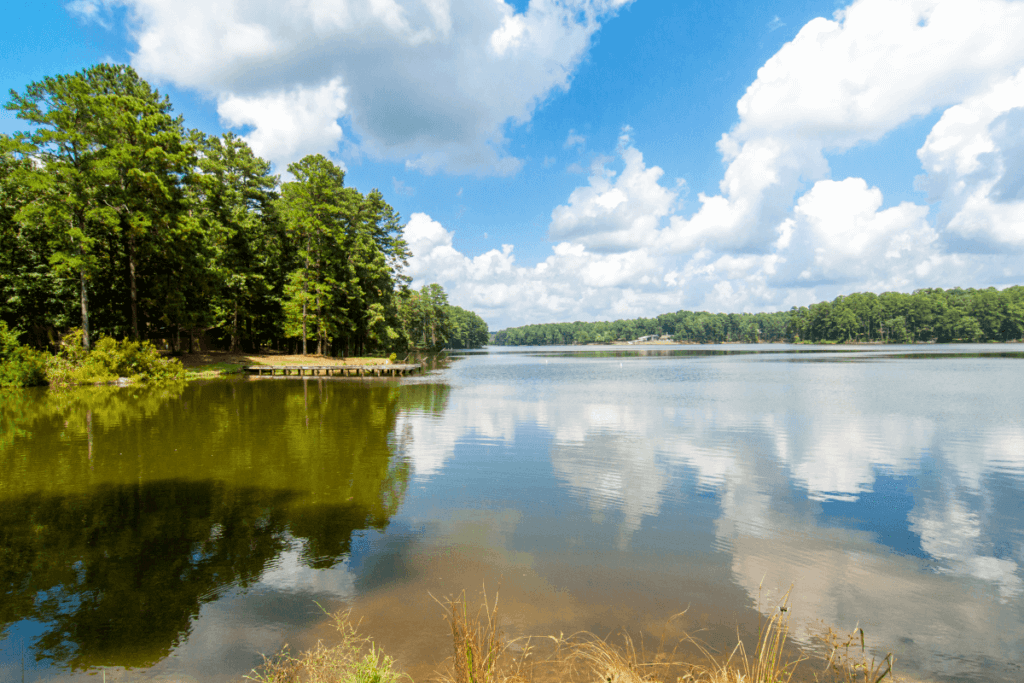Water Quality and Forestry Best Management Practices
It is through the wise management of our lands that we are able to protect and cleanse the water we need.

Best Management Practices
Forested lands are an important natural resource in Mississippi. They help protect and cleanse the water we need for drinking, residential use, irrigation, and industry.
According to the Southern Forest Resource Assessment (USDA Forest Service 2002), forested watersheds consistently yield lower sediment and nutrient contributions to surface waters and improve biological conditions. A multitude of benefits is generated through the wise management of these lands.
The Federal Clean Water Act of 1987 requires proper steps to be taken to prevent pollution to drinking water sources and protect water quality. When conducting forestry operations, using Mississippi’s Best Management Practices (BMPs) satisfies the requirements of the Clean Water Act. BMPs are a group of voluntary practices used to reduce water pollution.
Mississippi State Regulations Governing BMPs and Timber Practices
State Law 97-15-41 …
- It shall be unlawful and a misdemeanor for any person, firm, corporation, association, or organization to push, fell, or cut trees over six (6) inches in diameter into a running stream or deposit or leave in a running stream trees, more than six (6) inches in diameter, logs over six (6) inches in diameter or tree tops, without removing the same immediately, in such cases where such will materially impede the flow of or navigation upon such running stream.
- Any violation of this section shall be punishable by a fine of not less than twenty-five dollars ($25.00) and not more than two hundred dollars ($200.00).
- However, the provisions of this section shall not apply to the rafting and movement of logs in a running stream in the customary manner and for commercial purposes.
- However, the provisions of this section shall not be construed to affect in any way the riparian rights of any person, firm, corporation, association or organization.
Best Management Practices Handbook
The handbook (Fourth Edition, September 2008), which covers best management practices for forestry in Mississippi, includes BMPs in the following categories for uplands and wetlands:
- Streamside Management Zones
- Skid Trails and Haul Roads
- Forest Harvesting
- Site Preparation
- Tree Planting
- Artificial Revegetation of Disturbed Forest Sites
MFC’s Role in Water Quality
The Mississippi Forestry Commission’s role in water quality is to monitor the use of best management practices. Findings are reported to the Mississippi Department of Environmental Quality (MDEQ). It is estimated that forest activity occurs on nearly 850,000 acres annually in Mississippi.
Best Management Practice Monitoring
The MFC conducts a statewide monitoring survey and publishes a report every three years. The purpose of BMP monitoring is to evaluate the use of voluntary BMPs by the forestry community. By monitoring silvicultural activities, the overall integrity of water quality will improve and the restoration and protection of all watersheds.
The Mississippi Forestry Commission works with landowners, forest industry, loggers, and others to help ensure that forestry practices comply with the Water Quality Act and state laws.
2024 BMP Implementation Survey
Federally Mandated BMPs for Roads in Wetlands
- Permanent roads, temporary access roads, and skid trails in waters of the U.S. shall be held to the minimum feasible number, width, and total length consistent with the purpose of specific silvicultural operations and local topographic and climatic conditions.
- All roads, temporary or permanent, shall be located sufficiently far from streams or other water bodies (except portions of such roads that must cross water bodies) to minimize the discharge of dredged or filled material into U.S. waters.
- The road fill shall be bridged, culvert, or otherwise designed to prevent the restriction of expected flood flows.
- The fill shall be properly stabilized and maintained to prevent erosion during and following construction.
- Discharges of dredged or fill material into waters of the U.S. to construct a road fill shall be made in a manner that minimizes the encroachment of trucks, tractors, bulldozers, or other heavy equipment within waters of the U.S. (including adjacent wetlands) that lie outside the lateral boundaries of the fill itself.
- In designing, constructing, and maintaining roads, vegetative disturbance in the waters of the U.S. shall be kept to a minimum.
- The road crossing’s design, construction, and maintenance shall not disrupt the migration or other movement of those species of aquatic life inhabiting the water body.
- Borrow material shall be taken from upland sources whenever feasible.
- The discharge shall not take or jeopardize the continued existence of a threatened or endangered species as defined under the Endangered Species Act or adversely modify or destroy the critical habitat of such species.
- Discharges into breeding and nesting areas for migratory waterfowl, spawning areas, and wetlands shall be avoided if practical alternatives exist.
- The discharge shall not be located in the proximity of a public water supply intake.
- The discharge shall not occur in areas of concentrated shellfish population.
- The discharge shall not occur in a component of the National Wild and Scenic River System.
- The material discharge shall consist of suitable material free from toxic pollutants in toxic amounts.
- All temporary fills shall be removed entirely, and the area restored to its original elevation.
More Information
For more information about Water Quality and Best Management Practices, contact:
Todd Matthews
Forest Management Chief
tmatthews@mfc.ms.gov
